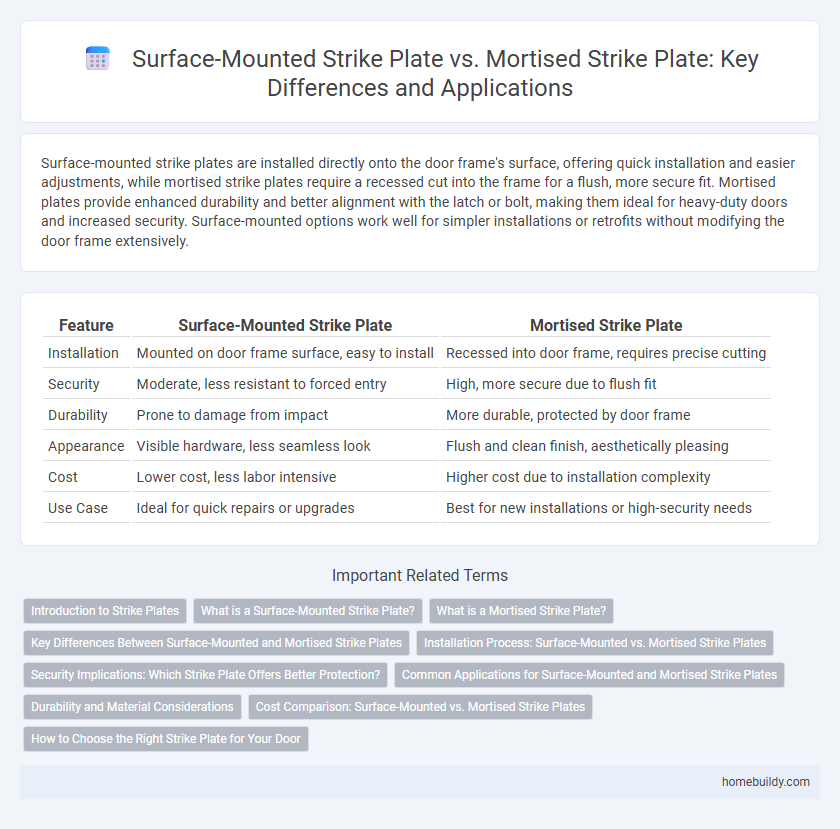Surface-mounted strike plates are installed directly onto the door frame's surface, offering quick installation and easier adjustments, while mortised strike plates require a recessed cut into the frame for a flush, more secure fit. Mortised plates provide enhanced durability and better alignment with the latch or bolt, making them ideal for heavy-duty doors and increased security. Surface-mounted options work well for simpler installations or retrofits without modifying the door frame extensively.
Table of Comparison
| Feature | Surface-Mounted Strike Plate | Mortised Strike Plate |
|---|---|---|
| Installation | Mounted on door frame surface, easy to install | Recessed into door frame, requires precise cutting |
| Security | Moderate, less resistant to forced entry | High, more secure due to flush fit |
| Durability | Prone to damage from impact | More durable, protected by door frame |
| Appearance | Visible hardware, less seamless look | Flush and clean finish, aesthetically pleasing |
| Cost | Lower cost, less labor intensive | Higher cost due to installation complexity |
| Use Case | Ideal for quick repairs or upgrades | Best for new installations or high-security needs |
Introduction to Strike Plates
Surface-mounted strike plates are installed directly onto the door frame's surface, offering quick and easy installation without extensive carpentry. Mortised strike plates require a precise recess cut into the door frame, providing a flush fit that enhances security and durability by reinforcing the latch area. Choosing between the two depends on the desired balance of installation convenience and structural strength for the locking system.
What is a Surface-Mounted Strike Plate?
A surface-mounted strike plate is a metal plate installed directly onto the door frame without requiring a recess or mortise, making it easier and faster to fit compared to mortised strike plates. This type of strike plate is commonly used in residential doors where installation simplicity and surface protection are priorities. Surface-mounted strike plates provide adequate reinforcement while minimizing the need for specialized tools or extensive alterations to the door frame.
What is a Mortised Strike Plate?
A mortised strike plate is a metal plate recessed into the door frame to create a flush and secure fit for the latch or deadbolt bolt. This installation method requires chiseling out a precise cavity, enhancing the door's structural integrity and increasing resistance to forced entry. Mortised strike plates are often preferred in high-security applications due to their durability and sleek finish compared to surface-mounted strike plates.
Key Differences Between Surface-Mounted and Mortised Strike Plates
Surface-mounted strike plates are installed directly onto the door frame's surface, offering easier and faster installation with minimal carpentry. Mortised strike plates require a recessed cut into the frame, providing a flush fit that enhances security and aesthetic integration. The choice impacts durability, security level, and installation complexity, making mortised plates preferable for high-security doors and surface-mounted plates suitable for retrofit or temporary solutions.
Installation Process: Surface-Mounted vs. Mortised Strike Plates
Surface-mounted strike plates are installed externally on the door frame, requiring minimal tools and less time, making them ideal for quick upgrades or repairs. Mortised strike plates necessitate chiseling a recess into the door frame, ensuring the plate sits flush for enhanced security and a cleaner appearance. The mortising process demands precision and more installation time but results in a more durable and aesthetically integrated lock system.
Security Implications: Which Strike Plate Offers Better Protection?
Surface-mounted strike plates provide quick installation but often lack deep anchoring, making them less resistant to forced entry compared to mortised strike plates. Mortised strike plates are embedded into the door frame, offering enhanced structural reinforcement and better distribution of impact forces, significantly improving security. Choosing a mortised strike plate with heavy-duty materials increases protection against kick-ins and other break-in attempts.
Common Applications for Surface-Mounted and Mortised Strike Plates
Surface-mounted strike plates are commonly used in applications requiring easy installation and adjustment, such as retrofitting existing doors or securing lightweight interior doors. Mortised strike plates are typically found in higher-security settings, including commercial buildings and exterior doors, due to their recessed installation providing enhanced strength and durability. Both types serve critical roles in door hardware systems, with surface-mounted options favoring convenience and mortised designs prioritizing security.
Durability and Material Considerations
Surface-mounted strike plates are typically made from stainless steel or heavy-duty aluminum, offering enhanced resistance to corrosion and wear, which contributes to their durability in exterior applications. Mortised strike plates, often crafted from solid brass or steel, are recessed into the door frame, providing stronger structural support and increased resistance to forced entry. When prioritizing longevity and material strength, mortised strike plates generally outperform surface-mounted options due to their integration within the frame and use of robust metals.
Cost Comparison: Surface-Mounted vs. Mortised Strike Plates
Surface-mounted strike plates generally cost less due to easier installation and minimal door modification requirements, making them a budget-friendly option for quick upgrades. Mortised strike plates involve deeper door frame recesses, leading to higher labor costs and potentially more expensive hardware but offer a more secure, flush finish. Choosing between the two depends on balancing upfront expenses against long-term durability and security needs.
How to Choose the Right Strike Plate for Your Door
Surface-mounted strike plates are easier to install and ideal for retrofit projects without modifying the door frame, while mortised strike plates provide a cleaner look and enhanced security by fitting flush within the door jamb. When choosing the right strike plate for your door, consider the level of security needed, door frame material, and installation complexity. Opt for mortised plates for solid wood frames and higher forced-entry resistance, while surface-mounted plates suit metal or composite frames with minimal installation time.
surface-mounted strike plate vs mortised strike plate Infographic

 homebuildy.com
homebuildy.com